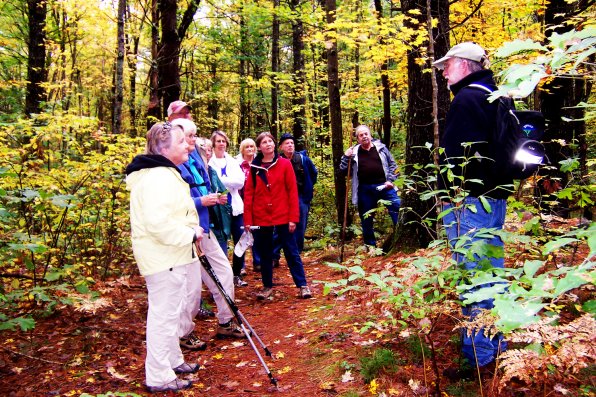When I was on a hike through the Hutchins Forest of Canterbury in early October, guide Kenneth Stern pointed out a clump of branches growing from the roots of an old stump that was once a stately American chestnut tree. Sadly, Stern did not offer much hope that the thin saplings could become mature trees. He forecast that the young sprouts would soon die from the same blight which had killed the parent tree, and he delivered a eulogy on the branches that were already dead.
There were about a dozen of us on the hike and we all stood around the small struggling American chestnut tree as if our presence could inspire it to make a courageous comeback. Chestnut trees at one time dominated the Hutchins Forest, which is now managed by the Society for the Protection of New Hampshire Forests, the state's oldest and largest non-profit land conservation organization. Quentin and Mary Hutchins donated the 88-acre plot.
Before succumbing to the catastrophic blight, the American chestnut trees occupied 25 percent of the eastern United States hardwood forests. But a fungal disease was accidentally introduced into North America on imported Asiatic chestnut trees. This chestnut blight was first discovered in 1904 at the New York Bronx Zoo. By 1950, 3 billion American chestnut trees had been killed by this airborne Asian bark fungus. Today, the American chestnut tree has been virtually eliminated, except for a few mature trees in a some isolated locations throughout the eastern United States, and also where small sprouts are springing up from the roots of old chestnut tree stumps, such as the small saplings Stern was showing to us.
In their heyday, American chestnut trees were highly valued for their timber. The trees grew straight and tall, some up to 100 feet. The wood, being very rot resistant, was used for making fence rails, railroad ties, furniture and musical instruments and in the construction of barns and houses. Today, some chestnut wood is being reclaimed from historic barns and made into fashionable furniture.
Chestnuts were another highly-prized resource of the American chestnut trees. Eugene Scott wrote in Waking Up: “I well remember the glorious days of autumn when we rose at dawn to beat the wild turkeys to the chestnut orchard to gather up the first nuts that had fallen during the night. No experience in all the years since has been so colored with sheer delight, with such fantastic enjoyment, as picking up chestnuts during the fall season.”
It is said that the aroma of “chestnuts roasting on an open fire” could be detected several blocks away.
In his 1936 poem, Evil Tendencies Cancel, Robert Frost mused about the future of the chestnut trees. He wrote, “Will the blight end the chestnut?/ The farmers rather guess not./ It keeps smoldering at the roots/ And sending up new shoots/ Till another parasite/ Shall come to end the blight.”
Stern, who serves on the Canterbury Conservation Commission and on the Board of Five Rivers Conservation Trust, said scientific efforts are being made to rescue the American chestnut trees. Perhaps a fungus could be found to counteract the chestnut blight fungus or an American chestnut tree could be produced that is immune to the blight. It was a hopeful note on which to conclude Stern's eulogy to the American chestnut tree. Frost's poetic prediction may someday come true.






















